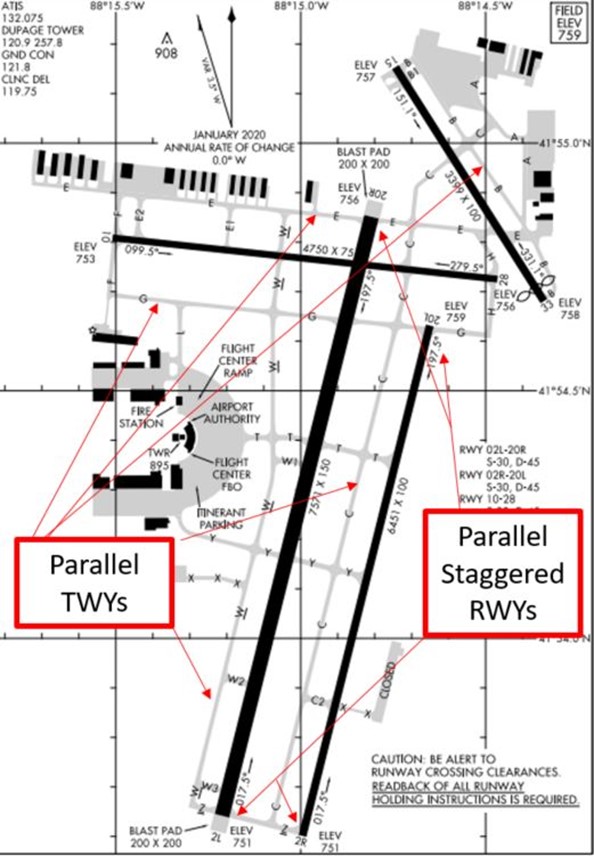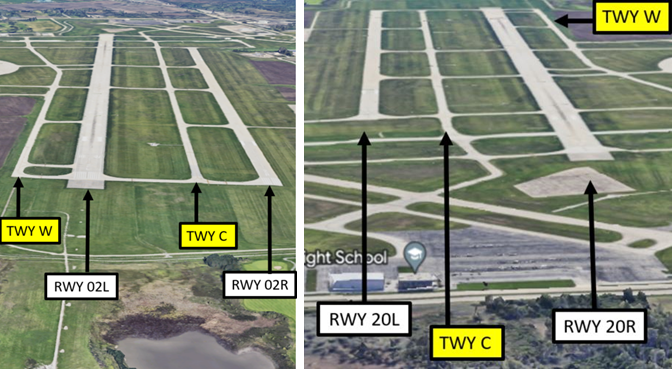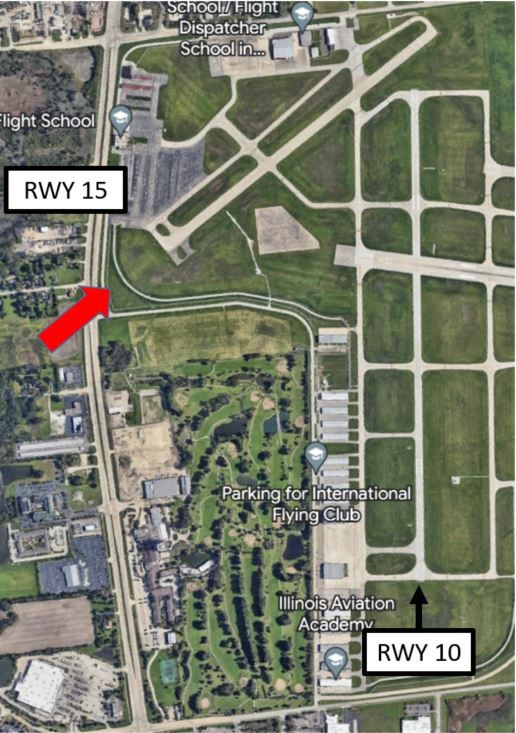DuPage Airport (DPA)
Know Before You Go
DuPage Airport (DPA) is located approximately 16 miles west of Chicago O’Hare International Airport (ORD). DPA averages approximately 370 aircraft operations daily with general aviation (both local and transient) making up over 93% of the traffic mix.
The airspace at DPA is Class D with a 3300’ MSL ceiling and underlies Chicago Class B airspace. (Refer to Sectional Chart).

There are 4 RWYS at DPA:
- Two parallel RWYs with staggered thresholds – RWY 02L/20R and RWY 02R/20L.
- RWY 10/28 intersects RWY 02L/20R.
- RWY 15/33 has a displaced threshold at the approach end of RWY 33.
- All RWYS have full-length parallel TWYs.
Parallel, staggered RWYs and full-length TWYS increase the risk of a Wrong Surface Event.
View a printable Pilot Handbook of the DPA information found on this Web page.
Below find various DPA-specific information and things to be aware of, as well as general information to inform your preflight planning. This will be reviewed quarterly and updated as needed. This information is to supplement the From the Flight Deck Videos that are produced by the FAA Runway Safety Group. Here you will also find information provided by the local air traffic controllers at the airport where you intend to fly. The information is subject to change. Not for navigation or legal* pre-flight action. Always refer to official pre-flight materials such as, but not limited to, NOTAMs, airport diagrams, VFR charts and airport construction notices for the latest airport-specific details.
DPA Tower is a 24 Hour Facility
Administrative Office Open 0700L to 1530L – M through F
Business Phone 630-587-7816
Hot Spots – There are no Hot Spots at DPA
Wrong Surface Landing-See Arrival Alert Notices
- The following shows how a Wrong Surface Landing risk exists due to parallel RWYs with staggered thresholds and full-length parallel taxiways at DPA.
- Parallel TWYs can also be mistaken as RWYs. Remember that RWYs have “white” markings. TWY markings are yellow.

- In the past, aircraft that were instructed to land on RWY 10 instead landed on RWY 15. (See illustration below)

Additional Cautions
- Deer, coyote, birds, and migratory waterfowl on in in vicinity of airport.
- Aircraft on short final to RWY 15 are not visible from the TWR due to trees.
- Several Flight Schools are located at the airport. Student training in progress.
The following is local airport specific Information that your TWR Controllers want to pass along.
General
- DPA is a busy training VFR tower and has flight schools onsite. Please be patient with the controllers and be vigilant of pilots in training.
Traffic Patterns
- DPA utilizes intersecting and parallel runways daily for traffic operations. Expect multiple traffic calls for aircraft landing on intersecting and parallel runways.
- Expect RWY 2R/20L as the main RWY for traffic patterns.
Ground
- Ground control is often combined with another position. Please be patient when awaiting instructions from the ground controller.
Take-off/Departure
- Pilots departing the airport are expected to begin their turns at the runway end. If a pilot wants an early turnout, please advise the tower.
- Please use the phrase “IFR” when requesting an IFR takeoff clearance.
Arrival/Landing
- Due to the nature of the DuPage Class D and the fact most aircraft depart and enter from the west, arriving aircraft may be routed for a sequence as far as 8 miles out. Listen carefully for the instructions and the assigned runway.
- Please use caution when aligning for arrival. The configuration of DPA’s runways may cause misalignment and wrong surface landings.
Special Traffic (Military / Commercial / Helicopter, etc.)
- Use caution when climbing out of DPA 3500 ft. airspace boundary. We underly ORD traffic patterns starting at 4000 ft.
- Use caution for IFR overflights transitioning the airspace at 3000 ft that are not on DPA TWR frequency.
Additional Information
- Please ask for clarification if you are unsure of any control instructions.
